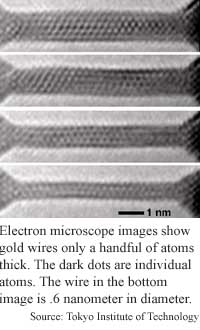
Atomic scale wire speed electrons
By Ted Smalley Bowen, Technology Research NewsWhile metals are well-known conductors, their properties at the atomic scale open the possibility of even faster electronics. Researchers at the Tokyo Institute of Technology have produced gold wire less than four atoms thick in their efforts to chart these properties.
The gold wires, which range from .6 to 1.3 nanometers in diameter and 3 to 15 nanometers in length, transported electrons many times faster than bulkier conduits. A nanometer is one millionth of a millimeter.
The research could benefit microelectronics, as well as the general understanding of the behavior of very small-scale matter. As researchers continue to shrink electronic circuits, they could eventually become small enough to take advantage of these different properties.
The researchers produced “nanowires through which electrons can [pass] with a very high speed -- one-hundredth the speed of light,” said Kunio Takayanagi, a physicist at the Tokyo Institute of Technology.
At such small scales, electrons pass through wires without scattering, he said. And because they don't scatter they don't generate heat, he said. Contending with heat is a major issue for computer chip manufacturers.
“With such a nanometer-scale perfect wire, you will have a lot of nice properties,” said Hongjie Dai, assistant professor of physical chemistry at Stanford University. “You get ballistic transport, with no scattering, since there are no defects [at the] nanometer scale. Electrons can move freely in there [because] there’s no resistance to [them].”
The researchers produced the wires by bombarding thin gold film with an electron beam. The process produced holes in the film, and the material between closely spaced holes constituted gold nanowires. In a cross-section of the thinnest wire, a ring of seven atoms surrounds a single atom. In the strips of gold thinner than 1.5 nanometers, the atoms take on a spiral structure like that of carbon nanotube atoms and similar to the molecular structure of DNA.
The same researchers produced thinner pieces of gold two years ago by using the tip of a scanning tunneling microscope to pull single-atom strands from a gold surface. However, the process did not allow them to extend the fragile strands beyond two nanometers, which is too short to be used as conducting wire, according to the researchers.
The laboratory technique for producing the nanowires uses a transmission electron microscope, which means it's likely to remain too expensive for commercial applications.
“It would be nice to have chemical ways to make such wires, so that you could have a lot of them. It would be nice to have a beaker full of such wires,” said Dai.
Dai estimates thin wire technology is 5 to 10 years from commercialization.
Takayanagi's colleague was Yukihito Kondo of the Tokyo Institute of Technology. They published their work on creating and characterizing the structure of gold nanowires in the July 28, 2000 Science. The research was funded by the Japan Science and Technology Corporation.
Timeline: 5-10 years
Funding: Government
TRN Categories: Semiconductors and Materials
Story Type: News
Related Elements: Image; Technical paper, "Synthesis and Characterization of Helical Multi-Shell Gold Nanowires," July 28, 2000, Science
Advertisements:
December 13, 2000
Page One
Nanotube fabric looms large
Silicon nanocrystals glow
Exploratory robot hops and rolls
Lasers flex gel muscles
Atomic scale wire speeds electrons

News:
Research News Roundup
Research Watch blog
Features:
View from the High Ground Q&A
How It Works
RSS Feeds:
News
Ad links:
Buy an ad link
| Advertisements:
|
 |
Ad links: Clear History
Buy an ad link
|
TRN
Newswire and Headline Feeds for Web sites
|
© Copyright Technology Research News, LLC 2000-2006. All rights reserved.